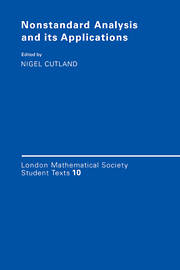Book contents
- Frontmatter
- Contents
- Preface
- Contributors
- AN INVITATION TO NONSTANDARD ANALYSIS
- INFINITESIMALS IN PROBABILITY THEORY
- INFINITESIMALS IN FUNCTIONAL ANALYSIS
- APPLICATIONS OF NONSTANDARD ANALYSIS IN MATHEMATICAL PHYSICS
- A LATTICE FORMULATION OF REAL AND VECTOR VALUED INTEGRALS
- AN APPLICATION OF NONSTANDARD METHODS TO COMPUTATIONAL GROUP THEORY
- SYNTACTICAL METHODS IN INFINITESIMAL ANALYSIS
- SOME ASYMPTOTIC RESULTS IN ORDINARY DIFFERENTIAL EQUATIONS
- SUPERINFINITESINALS AND INDUCTIVE LIMITS
- THE NON-LINEAR BOLTZMANN EQUATION FAR FROM EQUILIBRIUM
- INDEX
INFINITESIMALS IN PROBABILITY THEORY
Published online by Cambridge University Press: 05 June 2012
- Frontmatter
- Contents
- Preface
- Contributors
- AN INVITATION TO NONSTANDARD ANALYSIS
- INFINITESIMALS IN PROBABILITY THEORY
- INFINITESIMALS IN FUNCTIONAL ANALYSIS
- APPLICATIONS OF NONSTANDARD ANALYSIS IN MATHEMATICAL PHYSICS
- A LATTICE FORMULATION OF REAL AND VECTOR VALUED INTEGRALS
- AN APPLICATION OF NONSTANDARD METHODS TO COMPUTATIONAL GROUP THEORY
- SYNTACTICAL METHODS IN INFINITESIMAL ANALYSIS
- SOME ASYMPTOTIC RESULTS IN ORDINARY DIFFERENTIAL EQUATIONS
- SUPERINFINITESINALS AND INDUCTIVE LIMITS
- THE NON-LINEAR BOLTZMANN EQUATION FAR FROM EQUILIBRIUM
- INDEX
Summary
The aim of this article is to explain how and why the Loeb measure construction can be applied to problems which arise outside of nonstandard analysis. The Loeb measure and the necessary background from nonstandard analysis are presented in the paper of Lindstrøm in this volume. Most of the applications of Loeb measures in probability theory fit the following pattern. First, lift the original classical problem to a hyperfinite setting. Second, make some hyperfinite computations. Third, take standard parts of everything in sight to obtain the desired classical result. In keeping with this pattern, we shall concentrate on hyperfinite Loeb spaces, that is, Loeb spaces on hyperfinite sets. As we go along, we shall present several examples of applications of hyperfinite Loeb spaces to probability theory. However, our main emphasis will be on the general theory which underlies the applications.
We shall begin with a study of random variables on probability spaces, and then pass to a deeper parallel theory of stochastic processes on adapted spaces. The hyperfinite adapted spaces are counterparts of the hyperfinite Loeb spaces. Corresponding to the distribution of a random variable, we introduce the adapted distribution of a stochastic process. We shall focus on three features of hyperfinite adapted spaces: liftings, universality, and homogeneity. These features help to explain why the applications work. The adapted lifting theorem shows that standard stochastic processes can be lifted to hyperfinite processes with almost the same adapted distribution.
- Type
- Chapter
- Information
- Nonstandard Analysis and its Applications , pp. 106 - 139Publisher: Cambridge University PressPrint publication year: 1988
- 13
- Cited by



